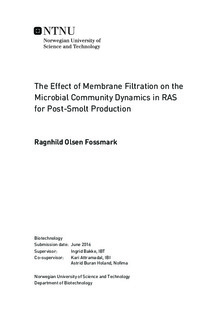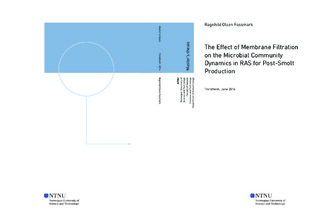| dc.description.abstract | An increased interest for recirculating aquaculture systems (RAS) the past years have led to more research on water treatment processes and how they affect water quality. Most studies have been focusing on the units governing the physicochemical parameters, however the microbial environment is also an important parameter in the cultivation of fish. Bacteria are highly abundant in the rearing water and thus in close contact with the fish. Knowledge on the potential health effects of the microbial environment in the cultivation of salmon fry, smolt and post-smolt are limited and remains to be studied.
Accumulation of solids is a known problem in RAS, and could affect the water quality and fish performance. The conventional particle removal systems in use today only manage to remove larger particles, leaving the fine solids in the system water for recirculation. Membrane technology has been proposed as a strategy for removal of the fine solids in the system and could potentially improve the water quality. The scope of this thesis was to evaluate the effect of membrane filtration on the bacterial concentrations and the microbial community structures in the rearing water of post-smolt production in two identical RASs, one control RAS (cRAS) and one RAS modified to include a membrane (mRAS). The community compositions of the gut microbiota from the post-smolts reared in the two systems were also investigated at the end of the experiment. To estimate the bacterial concentrations, flow cytometry analysis was used to count the bacteria in the rearing water. To investigate the microbial community compositions, 16S rRNA PCR/DGGE analysis was conducted.
Implementation of a membrane in the water treatment significantly reduced the bacterial concentrations in the rearing water. At the end of the experiment the bacterial concentrations of water in the fish tanks in mRAS were around 6 million/ml, and in cRAS 14 million/ml, respectively. The microbial community compositions in mRAS and cRAS were significantly different from each other, and the community compositions in mRAS were more diverse than those of cRAS. The water microbiota in both systems changed throughout the experiment, however it was observed a more stable microbiota over time in mRAS than cRAS. The microbial community compositions of the gut samples from mRAS and cRAS were significantly different from each other, thus the membrane filtration affected the gut microbiota of the salmon post-smolts. | en |

